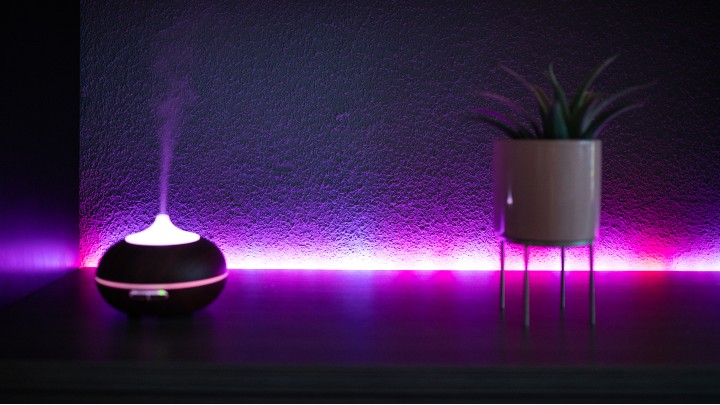Want to share feedback? Contact us.
LED strip lights are low voltage and generally safe to use in all applications. Unlike traditional light fixtures, they have fuse protection built into the transformer for extra protection.
What is the probability of LED lights overheating? Can they still be considered fire hazards?
Here’s if LED Strip Lights Can Cause Fire:
The likelihood of starting a fire due to LED strip lights is small because of their low voltage. The same cannot be said for poor-quality ones. Low-grade LED strip lights near a highly flammable material are extremely dangerous as they can get very hot.
LED strip lights are made of thin, flexible circuit boards with LEDs placed in arrays along their length. Lengths can vary from 1M to 5M spools.
The most common problems with strip lights are overheating and power cord failures. You have to understand that when many lights are strung together, there is bound to be more heat involved.
These light fixtures must be installed correctly for safety purposes.
The same care goes for LED strip lights. While they are typically low voltage (120V for line voltage), hot spots may develop on the strip over time if not correctly handled and fitted.
LED strip lights require a power adaptor that usually comes in the package. To avoid problems, you need to ensure that the power source is not overloaded.
Line-voltage strip lights may extend up to 50 meters. If you plug in multiples, the power source may end up overburdened.
You should also avoid installing your LED strip lights near flammable materials.
While the lights’ heat emission is relatively low, a simple spark due to improper wiring may ignite the material and start a fire.
Do LED Strip Lights Get Hot Enough to Start a Fire?
The LED strip light is designed with built-in limit resistors. As long as the voltage stays at a specific range, there should be no reason to worry about starting a fire.
Moreover, LED lights are low voltage compared to incandescent bulbs, and LEDs use a lot less electricity.
An incandescent bulb can reach 216 degrees Celsius after only three minutes of operation. In contrast, a LED light bulb only heats up to 32 degrees Celsius after the same period.
It goes without saying that LED lights, like other light fixtures, require proper installation.
Since they are more sophisticated than incandescent ones, you should strictly follow the manufacturer’s specifications to be safe.
LED lights need a driver to regulate power. This is crucial for LED circuitry to operate and avoid system failure.
If there is a heating issue on your LED strip lights, this may be due to the driver or capacitor.
Fortunately, most standard LED lights already have the driver incorporated in the bulb, so you do not need to install an external driver.
Another concern is air circulation. Strip lights tend to get hotter when installed in tight spaces.
The more LEDs on the strip, the higher the heat is generated, so there should be enough room for the air to flow and take away the excess heat.
Avoid mounting LED strip lights behind the curtains or under carpets or rugs. Placing them near flammable items like alcohol, aerosol cans, cardboard, and paper is also dangerous.
Heaters near your LED strip lights are a safety hazard, so you should be careful with the placement.
Water near your strip lights is not recommended, so you should avoid putting them in the bathroom or other water sources.
When installing LED strip lights, make sure that the cables connecting to the power outlet are not exposed or damaged.
Cables are insulated to protect you from the currents flowing through them. If broken, they can cause power surges that lead to strip lights overheating.
Finally, you should always check if the power supply is not overloaded. At least 20% of the wattage of the total strip consumption should be observed if you connect multiple strips together.
How Long Can LED Strip Lights Stay On?
High-quality LED strip lights are good for around six years of continuous use. They should give you at least 50,000 hours before gradually losing their light output.
With any light fixture, leaving LED strip lights on for a more extended period is considered a fire risk. While they are admittedly safer to use than other bulbs, you should always be on the safe side.
Besides, prolonged use of LED lights day by day will only result in your utility bills increasing.
If you have trouble remembering when to turn off your LED strip lights, you should invest in timers or motion sensors that can switch the lights on and off at an appropriate time for you.
Is It Okay to Leave LED Strip Lights on All Night?

Yes. LED strip lights can stay on all night and even more extended periods if necessary.
Since they utilize less power and produce less heat, LED lights are excellent for long hours of usage.
LEDs are the safest night lights or background accent lights because they will not overheat, unlike incandescent bulbs.
If you place your hand over an incandescent bulb, you will feel how hot it can get. This is because it uses a filament to generate light.
When you turn it on, a significant portion of the energy is wasted in the form of heat. This heat is commonly associated with fire.
On the other hand, LED lights are more efficient at converting energy to light. Instead of a filament, they use a semiconductor material to produce light.
This efficacy means there is less heat generated. When there is less heat, the risk of starting a fire is lower.
Therefore, it is definitely safe to leave your LED strip lights on all night long.
With LED lights, you will also save money in the long run since they utilize about 85% less electricity than conventional light bulbs.
Is It Okay to Leave LED Strip Lights on 24/7?
If you installed your LED strip lights correctly with proper wattage and air circulation, they could be left switched on 24/7.
LED lights deteriorate from high temperatures, not from switching on and off. When heat factors are managed efficiently, there should be no problem letting the bulbs stay switched on for longer periods.
You just need to ensure that no objects hinder the strip lights’ heat dissipation. Flammable materials near your LEDs are also a big no.
While LED strip lights are not fire hazards, it is still advisable to switch them off after 12 hours of use. This is to save the bulbs’ lifespan. This can also help to prevent bugs from being attracted to LED strip lights.
How Often Do LED Strip Lights Catch Fire?
Unlike most lightbulbs that start a fire when they overheat, LED lights produce light at a lower temperature, so the chances of this happening are low.
The semiconductor on LED bulbs efficiently generates light without making too much heat, which is why they are excellent for long-term use.
It is essential to know how to keep your LED lights safe. These light fixtures require proper installation, so they are guaranteed safe for your home.
You must utilize only the manufacturer’s recommended and compatible parts with your LED strip lights. This includes the driver that will regulate the right amount of electricity to the fixture components.
If you must install your LED bulbs in enclosed fittings, you should use those stamped with “enclosed fixture rated” to avoid overheating.
Finally, only use LED strip lights with recognized and referenced product safety marks, like UL or ETL. These indicate that your lighting meets the testing safety standards.
Those LED lights that overheat and cause fires are usually low-grade ones from disreputable manufacturers that even contain toxic substances.
Why Are My LED Strip Lights Glowing When Turned Off?
LED strip lights glowing even after switched off is a common issue with poor quality bulbs.
The quality of LED lighting available in the market varies a lot. If you come across low-grade ones, they will most likely glow, flicker, or buzz when powered off.
You should replace the bulb with one from a recognized LED manufacturer to prevent this from happening.
Another reason for the LED strip lights glowing is a problem with the electrical circuit.
Sometimes, residual electricity gets past the light switch even when turned off. This causes the bulb to glow dimly and consistently after use.
Electrical circuit glitches may occur if you use the wrong type of light switch, connected switch, or dimmer.
It may also be because the neutral wire on the circuit is not correctly connected to the earth wire.
An electromagnetic induction may also be why electricity is picked up from interconnected cables.
You should consult with an electrician if you suspect problems with the wiring in your home. They will find out if the glowing glitches are happening due to wiring issues or closely packed cables.
While at it, the electrician will also check if your switch or dimmer is suitable for your LED strip lights and replace them if necessary.
There were also instances when glowing LED strip lights had nothing to do with the bulb quality and electrical circuit.
LED bulb’s composition makes it possible to store a small amount of energy even after turning the switch off. The serial connection clamps the circuit, causing a low voltage to drop on the driver and make the bulb glow dimly.
The phosphor layer of LEDs may also keep some energy stored for a while longer.
If you want to test if this is the case, you should remove the LED bulb from the socket after switching it off and see if it glows or not. If it does, then it is because of residual energy.
